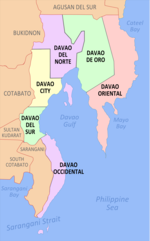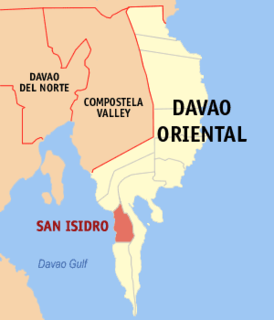
San Isidro, officially the Municipality of San Isidro, is a 3rd class municipality in the province of Davao Oriental, Philippines. According to the 2015 census, it has a population of 36,032 people.

Malungon, officially the Municipality of Malungon, is a 1st class municipality in the province of Sarangani, South Cotabato, Philippines. According to the 2015 census, it has a population of 103,604 people.

Asuncion, officially the Municipality of Asuncion, is a 1st class municipality in the province of Davao del Norte, Philippines. According to the 2020 census, it has a population of 61,893 people.
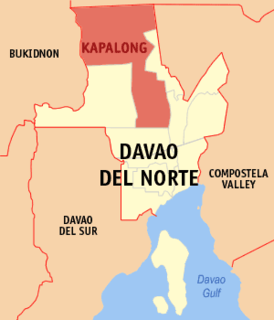
Kapalong, officially the Municipality of Kapalong, is a 1st class municipality in the province of Davao del Norte, Philippines. According to the 2020 census, it has a population of 81,068 people.
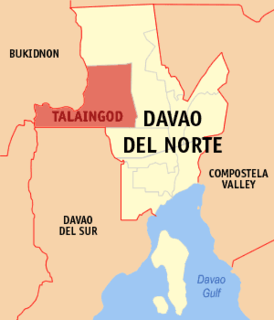
Talaingod, officially the Municipality of Talaingod, is a 2nd class municipality in the province of Davao del Norte, Philippines. According to the 2020 census, it has a population of 28,333 people.

New Corella, officially the Municipality of New Corella, is a 2nd class municipality in the province of Davao del Norte, Philippines. According to the 2020 census, it has a population of 57,913 people.
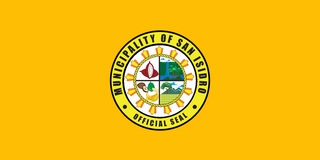
San Isidro, officially the Municipality of San Isidro, is a 5th class municipality in the province of Davao del Norte, Philippines. According to the 2020 census, it has a population of 27,233 people.

Laak, officially the Municipality of Laak, is a 1st class municipality in the province of Davao de Oro, Philippines. According to the 2015 census, it has a population of 73,874 people.

Maragusan, officially the Municipality of Maragusan, is a 1st class municipality in the province of Davao de Oro, Philippines. According to the 2015 census, it has a population of 60,842 people.
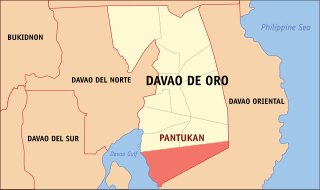
Pantukan, officially the Municipality of Pantukan, is a 1st class municipality in the province of Davao de Oro, Philippines. According to the 2015 census, it has a population of 85,899 people.

Don Marcelino, officially the Municipality of Don Marcelino, is a 3rd class municipality in the province of Davao Occidental, Philippines. According to the 2020 census, it has a population of 45,540 people.

Jose Abad Santos, officially the Municipality of Jose Abad Santos, is a 1st class municipality in the province of Davao Occidental, Philippines. According to the 2020 census, it has a population of 73,381 people.

Kiblawan, officially the Municipality of Kiblawan, is a 2nd class municipality in the province of Davao del Sur, Philippines. According to the 2015 census, it has a population of 48,897 people.
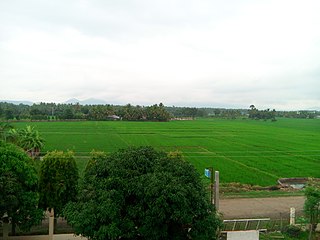
Magsaysay, officially the Municipality of Magsaysay, is a 3rd class municipality in the province of Davao del Sur, Philippines. According to the 2015 census, it has a population of 53,876 people.

Malalag, officially the Municipality of Malalag, is a 2nd class municipality in the province of Davao del Sur, Philippines. According to the 2015 census, it has a population of 38,731 people.

Santa Maria, officially the Municipality of Santa Maria, is a 2nd class municipality in the province of Davao Occidental, Philippines. According to the 2020 census, it has a population of 57,526 people.
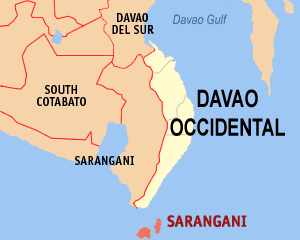
Sarangani, officially the Municipality of Sarangani, is a 4th class municipality in the province of Davao Occidental, Philippines. According to the 2020 census, it has a population of 22,515 people.

Cateel, officially the Municipality of Cateel, is a 2nd class municipality in the province of Davao Oriental, Philippines. According to the 2015 census, it has a population of 40,704 people.
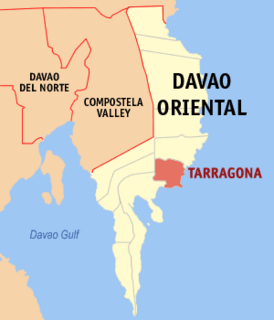
Tarragona, officially the Municipality of Tarragona, is a 3rd class municipality in the province of Davao Oriental, Philippines. According to the 2015 census, it has a population of 26,225 people.

San Ricardo, officially the Municipality of San Ricardo, is a 5th class municipality in the province of Southern Leyte, Philippines. According to the 2015 census, it has a population of 10,494 people.



























